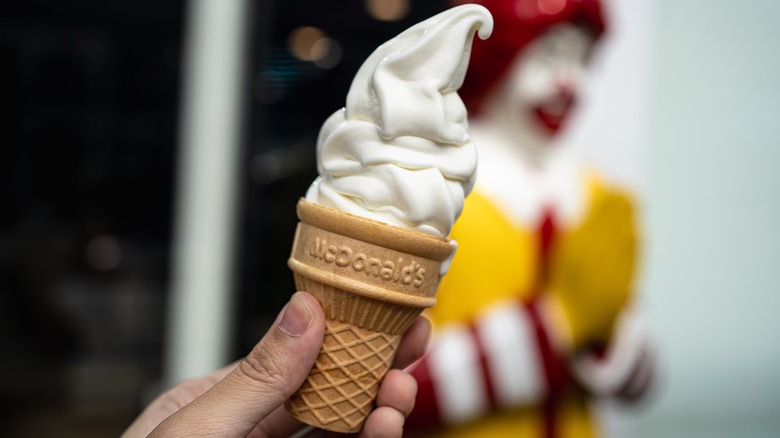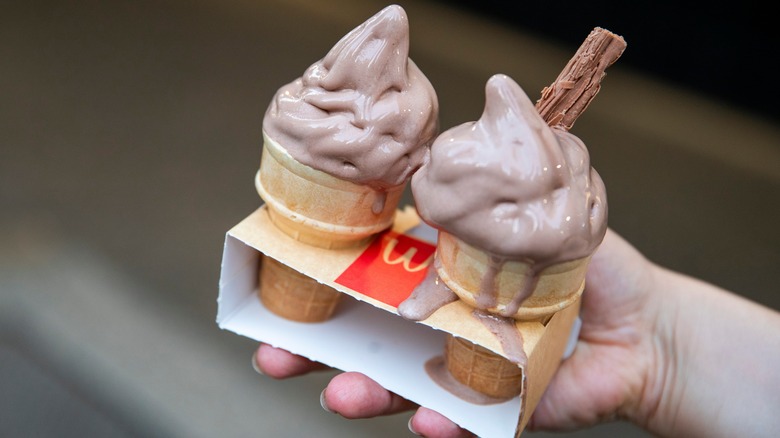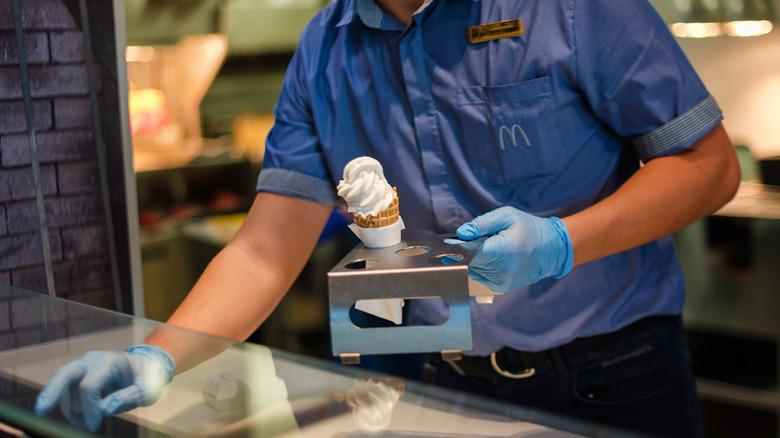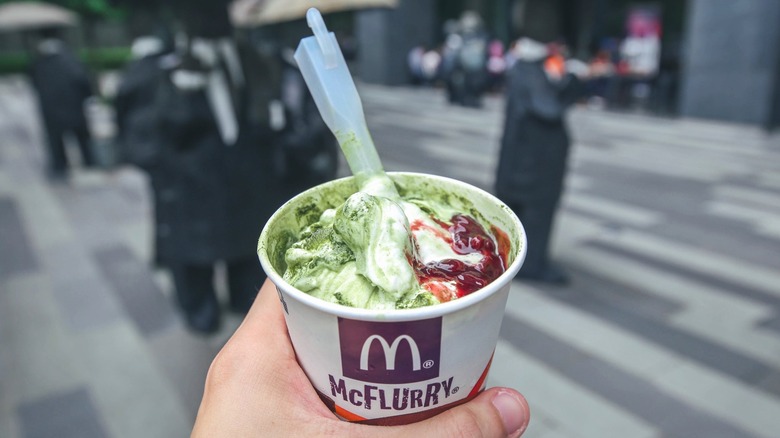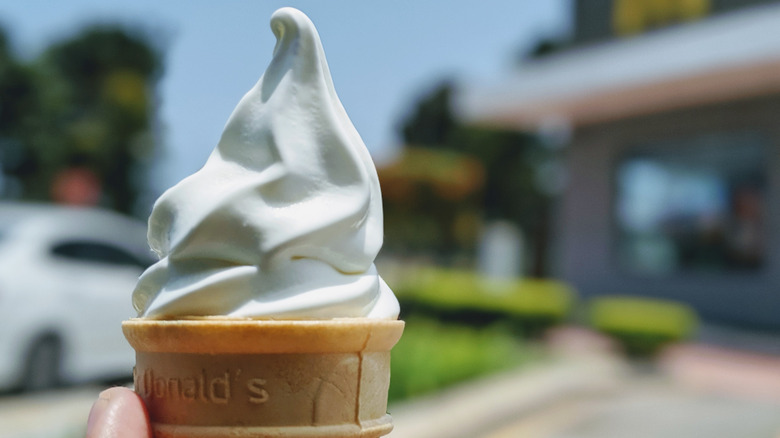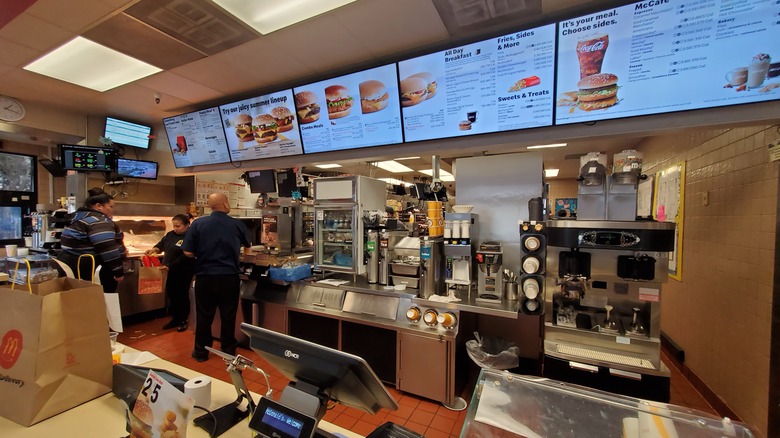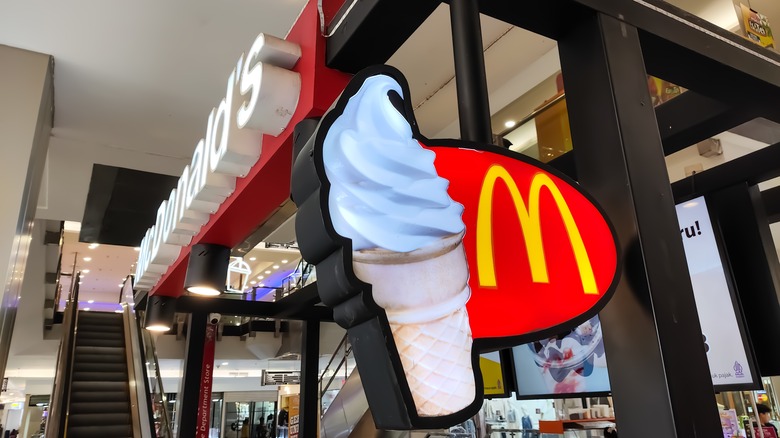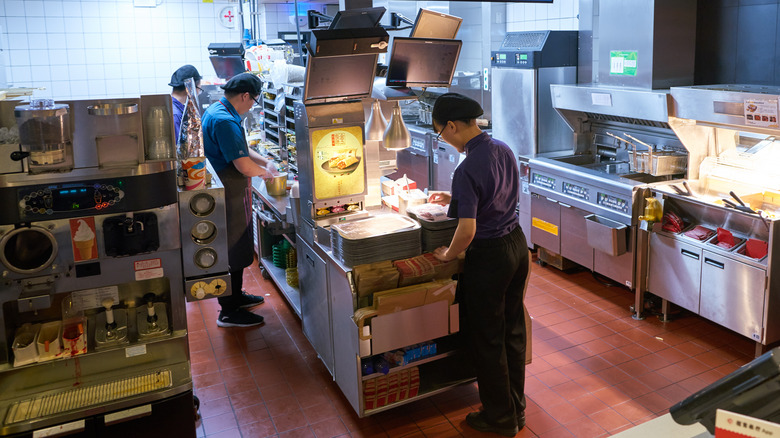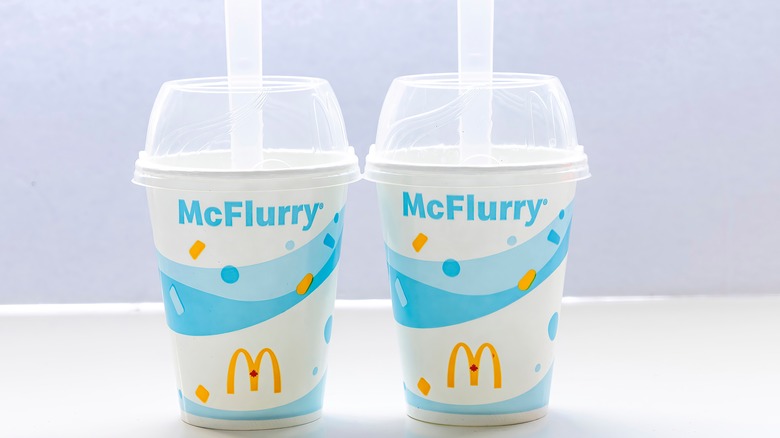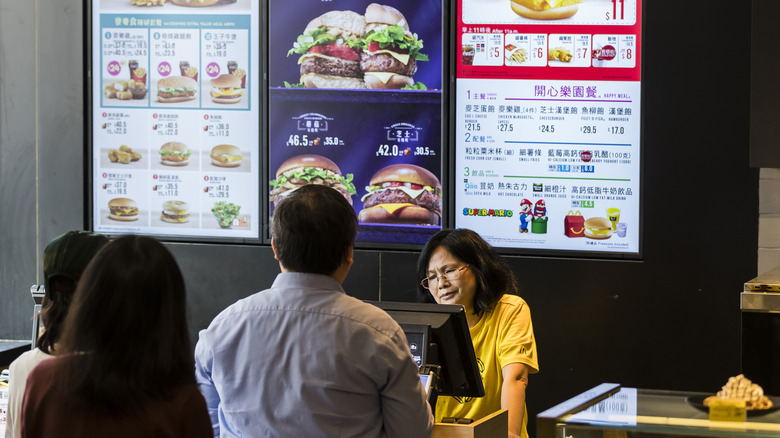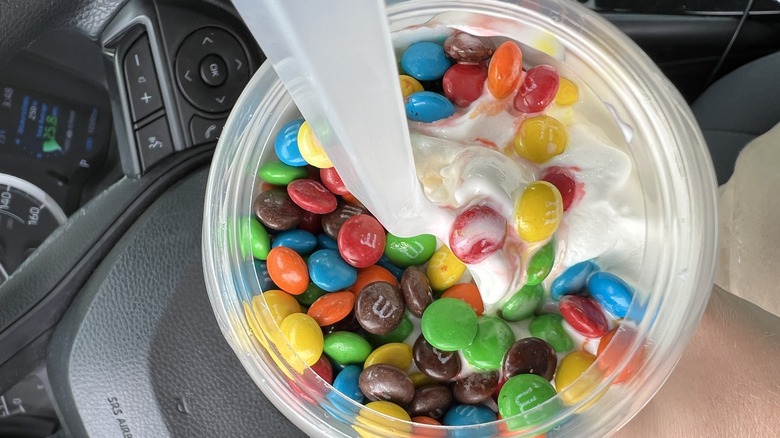10 Things You Should Definitely Know About McDonald's Ice Cream
Forget the McNuggets and the Big Mac for a second, because it's time to wax poetic about the unsung hero of the Golden Arches: ice cream. Some form of this frozen dessert has been featured on the menu at McDonald's since its inception. Decades later, ice cream remains one of the most fairly priced items on the menu — even if it's infamously hard to order, thanks to those pesky broken machines.
Admittedly, today's offerings look a little bit different to the standard cones doled out in the 1940s. While some forms of ice cream are longtime McDonald's classics — such as the vanilla cone and hot fudge sundae — others have come and gone over the years. We didn't even have McFlurries until one wise franchisee (to whom we owe a lifelong debt) decided to experiment with ice cream toppings in 1995.
With a history that spans over eight decades, there's a lot more to this sweet treat than meets the eye. We've delved deep into its sweet (and sometimes controversial) history to give you the comprehensive scoop on McDonald's ice cream.
Technically, it's not ice cream
We'll start with the most sobering truth on this list: McDonald's ice cream isn't actually ice cream. Yes, it contains a lot of the same ingredients — such as milk, sugar, and cream — but to get technical, it doesn't have the right nutritional composition to meet the strict definition of "ice cream" set by the United States Department of Agriculture (USDA).
As per these guidelines, a dessert needs to be at least 10% milk fat to legally count as ice cream. The McDonald's small Vanilla Cone comes in at 200 calories with 5 grams of fat, and the large boasts 300 calories with 8 grams of fat. That means that it's not quite enough fatty enough to make the cut (which isn't a complaint you often hear about McDonald's). Instead, it sits firmly in soft serve territory, a definition that encompasses desserts containing 3% to 6% milk fat.
There's a reason why McDonald's leans towards soft serve, not ice cream. Soft serve tends to be 30% to 70% air, which gives it a smoother, glossier finish that tends to look much more consistently aesthetically pleasing when dispensed into a cone or cup. It also doesn't hurt that it tends to be the cheaper option and can be stored at a higher temperature. That's why so many "ice creams" on fast food chain menus are also technically soft serve — but also boast vague names like "Vanilla Cone."
It secretly changed its recipe (and nobody even noticed)
In 2017, McDonald's made a startling confession. That ice cream we all knew and loved? Well, it was changing the recipe. In fact, it had already changed the recipe in thousands of locations, and we just didn't notice.
The transition began in 2016 in an effort to scrub artificial flavors, colors, and preservatives from the chain's menu. It was an easier feat than you would think. McDonald's ice cream was already free of artificial colors and preservatives, which meant that all it had to do was swap out the artificial flavors. While you'd think that messing around with the flavors of such a beloved dessert would spark some backlash, it was hard to argue with McDonald's new recipe when it tasted identical enough to its predecessor that the chain itself had to tell us it had changed six months later. "We worked closely with our culinary team to ensure taste was not impacted," Darci Forrest, McDonald's then-senior director of menu innovation, explained to CNBC.
Nowadays, McDonald's ice cream contains milk, sugar, cream, corn syrup, natural flavor, mono and diglycerides, cellulose gum, guar gum, carrageenan, and vitamin A palmitate. Other menu items underwent similar ingredient makeovers, with artificial preservatives stripped from the Chicken McNuggets and high fructose corn syrup removed from its burger buns and shakes, but it was the ice cream's transformation that made the most headlines.
International restaurants have more creative ice creams
The U.S. isn't exactly suffering when it comes to novelty McDonald's ice cream flavors (for proof, just see Kit Kat Banana Split and the Grandma McFlurry), so there may be a touch of a "the grass is always greener" sentiment when we say that its international restaurants offer better options. While you can always find some variation on classic vanilla ice cream at most McDonald's locations across the globe, the full dessert menu differs from country to country with toppings and flavors that often reflect local culture or trends.
Like the U.S., international menus are always changing. Some of the highlights from the McDonald's of days gone by include the Matcha McFlurry (available in Japan, Vietnam, and Thailand), the Pistachio Dream (a vanilla sundae served with creamy pistachio and freeze-dried strawberries in Hungary), the Cilantro Sundae (which is exactly what it sounds like, and proved extremely divisive when added to menus in China in 2022), the Pineapple Oreo McFlurry (a unique concoction from Colombia), and the Cadbury's Creme Egg McFlurry (limited to Canada and the U.K.).
Fans don't always take the global ice cream borders well. When McDonald's revealed that the Cadbury's Creme Egg McFlurry was returning to Canada in 2024, for example, American fans of the Golden Arches were outright offended that it — and other exciting McDonald's flavors, for that matter — had skipped going Stateside. As one Instagram user so eloquently put it, "WHY IS IT ALWAYS OTHER COUNTRIES."
The vanilla ice cream doesn't necessarily contain vanilla
Remember when we said that McDonald's reformulated its ice cream to be free of artificial colors, flavors, and preservatives? Well, that may not be strictly true. In 2020, McDonald's was slapped with a proposed class action lawsuit alleging that the flavoring behind its iconic desserts is actually partially derived from vanillin, not vanilla bean.
A lot of companies use vanillin instead of vanilla bean in their products. The issue here is that McDonald's lists its ice cream as containing "natural flavors" when most vanillin is actually made synthetically from petrochemicals. While the ingredients list never explicitly mentions vanilla bean, the complaint claimed that the absence of "artificial flavors" on this list would lead the majority of customers to assume that real vanilla fell under that "natural flavors" banner and therefore feel more comfortable paying a premium for what they assume is a high-quality product.
There's been a surge in flavoring-related class action lawsuits in recent years, with the likes of Breyers, Trader Joe's, and Blue Diamond all facing legal action over the validity of their vanilla. In fact, a lawyer named Spencer Sheehan famously filed over 100 cases about imitation vanilla in the space of two years. The reality is that these cases are often dismissed, with legal experts telling Business Insider that they rarely have merit as customers don't expect all products to contain natural vanilla. That was the case with the McDonald's lawsuit, which was ultimately dismissed in 2021.
There's a reason why the ice cream machine is always down
The unspoken rule about McDonald's ice cream is that you should never get too excited about it until you're actually holding it in your hands. Its ice cream machines are notoriously unreliable, with the euphoric high of an incoming sweet treat often shot down by the phrase, "Sorry, the machine's not working right now." It's so common that there are even websites dedicated to tracking operational machines, and rival fast food chain Wendy's called out the issue in a mixtape (yes, really).
While sometimes the machines are legitimately broken (more on that later), there's another, very valid reason why they're often unavailable. Restaurants have been able to purchase ice cream machines from Italian manufacturer Carpigiani since 2017, but the vast majority use machines from Taylor Company. The company offers a specific model that's exclusive to McDonald's — and it is known to take a very long time to clean.
Although the entire process is automatic, machines require four hours every single day to fully self-clean and sanitize. Most restaurants try to get this done at night when theoretically fewer customers crave ice cream. However, the machines also have a habit of presenting error messages mid- or post-clean, which then means the entire process needs to start fresh, and can easily roll over into the next day. So, while it doesn't soften the blow of being denied your McFlurry, just know that just because the machine's unavailable doesn't mean it's actually broken.
The law was changed to fix McDonald's ice cream machines
On those occasions where the McDonald's ice cream machines are actually broken, franchisees have long faced one heck of a conundrum. Thanks to a clause of the Digital Millennium Copyright Act (DMCA), only authorized technicians had permission to bypass the software's digital lock and fix these machines. That would be fine if you could call one in within 24 hours, but restaurant owners have claimed that it can take as long as 90 days to arrange a visit, with each location losing an estimated $625 per day in the meantime.
Luckily, this is no longer the case. After nonprofit group Public Knowledge and DIY repair site iFixit pushed for franchise owners to gain the right to fix their own ice cream machines — a process that included iFixit taking a machine apart to prove how easy it would be to fix – the Federal Trade Commission added an exception to DMCA in October 2024 that did just that. Just don't mistake that for an overnight fix. While it's now legal for restaurants to fix their own machines, iFixit stressed that the update still "doesn't allow us to share or distribute the tools necessary to do so." Broken machines are still very much an issue, as proven by the fact that, at the time of writing, tracking website McBroken claimed that 14.72% of machines in the U.S. are out of service. However, at least we're on the right track.
Hackers once sued McDonald's over its ice cream machines
Before the Federal Trade Commission made an exception to the Digital Millennium Copyright Act that would allow franchisees to fix their own ice cream machines, some people had already figured out how to do it for themselves — even if it wasn't entirely allowed. A three-person startup named Kytch came up with a handy device that could attach to Taylor Company ice cream machines and hacked its software to help restaurant owners monitor and prevent any issues, and keep the soft serve flowing all day long.
As it turns out, McDonald's wasn't particularly happy about this development. In 2020, the chain circulated an email among franchisees, warning them that the devices posed a safety hazard. Business dropped dramatically for the startup and in 2023 it filed a lawsuit against Taylor Company after discovering that it allegedly helped orchestrate the email in an effort to eliminate Kytch as a potential competitor.
Kytch also filed a separate case against McDonald's itself, seeking $900 million in damages for what it claimed was an effort to "drive Kytch out of the marketplace," (via Court Listener). It also accused both McDonald's and Taylor Company of trying (and failing) to copy its technology. Who knew ice cream could cause so much drama?
The McFlurry wasn't actually invented in the U.S.
For better or worse, McDonald's is quintessentially American. By that logic, you would assume that all of its most iconic offerings — like the McNuggets, Big Mac, McChicken, or anything else with "Mc" or "Mac" in the name — are equally red, white, and blue in origin. But surprisingly, the McFlurry bucks the trend; the chain's most iconic ice cream is technically more just red and white, as it actually heralds from Canada.
Back in 1995, the first-ever McFlurry was whipped up by Canadian franchisee Ron McLellan. His restaurant in Bathurst, New Brunswick, served the inaugural McFlurry (which contained Oreo pieces) on June 7 of that same year. McDonald's soon expanded the menu item to select restaurants in Toronto, before starting testing in the U.S. in 1997. By March 1998, you could order a McFlurry nationwide in both the U.S. and Canada, with the ice cream rapidly working its way through other regions.
Over 20 years later, you can find the humble McFlurry all over the world. While they remain mostly similar to the iteration found in Canada in the '90s, some of the more practical elements have changed with time. For one thing, McDonald's weird but iconic hollow spoons are now a thing of the past, and many countries have ditched the plastic lids for more environmentally-friendly cardboard packaging.
It's unhealthier in some countries than others
Not all McDonald's ice cream is built equal. While the final product is similar from country to country, the exact recipe can differ. By no means is any country serving a "healthy" McFlurry, you may be surprised by just how much the nutritional values can vary for the same products, depending where you are in the world.
For example, a regular Oreo McFlurry in the U.S. contains 410 calories, with 7 grams of saturated fat and 48 grams of sugar. The same Oreo McFlurry in the U.K. is significantly lighter, with 260 calories, 6 grams of saturated fat, and 32 grams of sugar. Meanwhile, Canada veers in the complete opposite direction health-wise, offering a regular Oreo McFlurry that contains 570 calories, 12 grams of saturated fat, and a whopping 68 grams of sugar.
Some of this comes down to how the nutritional values of the toppings themselves vary worldwide, with Oreos famously following a different recipe in the U.K. than in the U.S. However, even the more basic offerings can differ between countries. The classic vanilla cone may contain 200 calories in the U.S., but it contains 148 calories in the United Arab Emirates, 137 in Australia and Hong Kong, and 133 in Singapore. You get the gist. While this doesn't necessarily make one country's menu better or healthier than the other, it's worth noting that just because the Golden Arches are identical, doesn't mean the ice cream follows the same rules.
Not all restaurants flurry their McFlurries
What is a McFlurry if not flurried? From the beginning, the main thing that has always separated this dessert from a generic sundae is the fact that the toppings and soft serve are mixed together (or flurried), so tiny fragments of said toppings are dispersed evenly throughout. Nowadays, however, that isn't always the case.
McDonald's hasn't even tried to hide the fact that restaurants in Australia stopped flurrying their McFlurries in 2015. "The machines took up considerable space in our kitchens, so the decision was made that they would be hand stirred — with love — by our crew," a spokesperson told Buzzfeed. That's all well and good, but customers were left fairly outraged by the change, with tourists also shocked to discover un-flurried McFlurries when traveling Down Under.
This problem isn't necessarily restricted to Australia. Since McDonald's switched out its hollow plastic spoons, which were traditionally attached to the machine to flurry the soft serve, customers in the U.S. have also shared concerns about the state of McFlurries. While U.S. restaurants now have reusable plastic spindles that take the place of the spoon, workers from other countries have claimed that they now also hand mix McFlurries. Whatever the method, customers aren't impressed. "I was wondering how they stirred the McFlurries with the new wooden spoons," said one frustrated TikToker in 2023, revealing a McFlurry where the toppings were very much limited to the top of the tub. "They don't is the answer."
